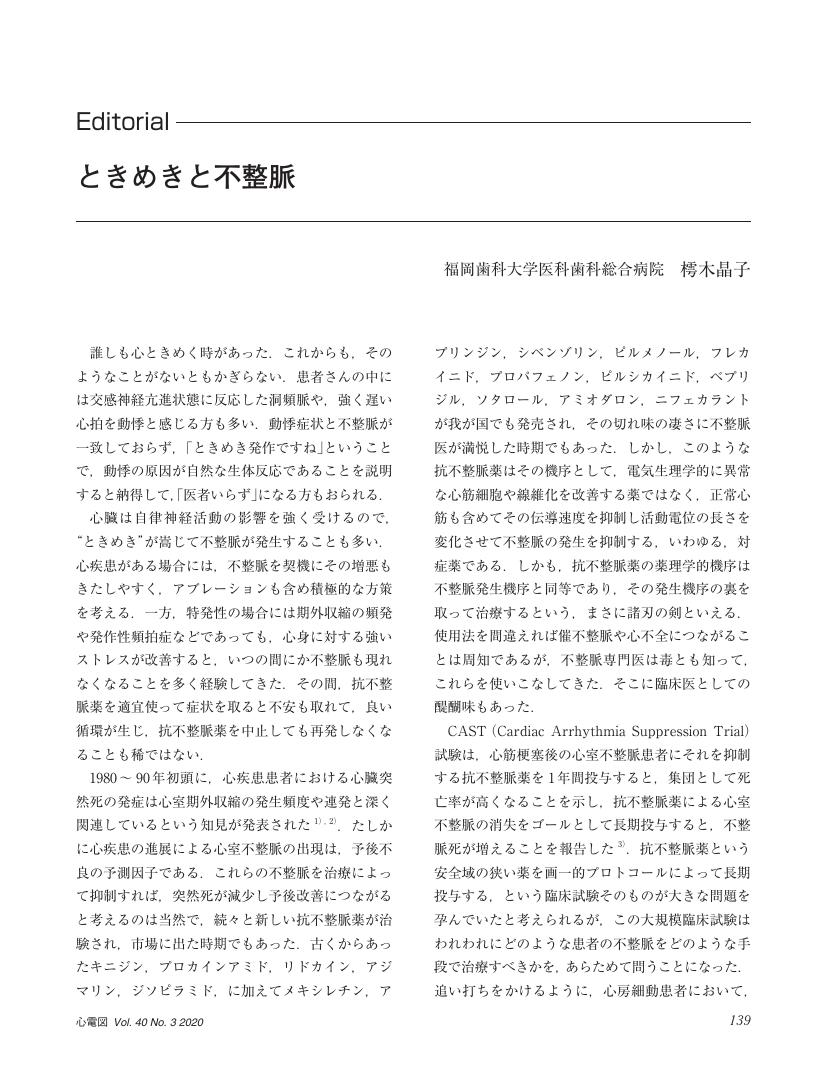3 0 0 0 OA 日循協心電図コード2005 (1982年版ミネソタコード準拠)
- 著者
- 豊嶋 英明 宇佐見 隆廣 樗木 晶子 堀部 博
- 出版者
- 社団法人 日本循環器管理研究協議会
- 雑誌
- 日本循環器病予防学会誌 (ISSN:13466267)
- 巻号頁・発行日
- vol.40, no.2, pp.138-154, 2005-04-30 (Released:2009-10-16)
2 0 0 0 OA ときめきと不整脈
- 著者
- 樗木 晶子
- 出版者
- 一般社団法人 日本不整脈心電学会
- 雑誌
- 心電図 (ISSN:02851660)
- 巻号頁・発行日
- vol.40, no.3, pp.139-140, 2020-10-30 (Released:2020-11-19)
- 参考文献数
- 4
2 0 0 0 OA 高齢者と若年者における入浴時の呼吸・循環動態の変化
- 著者
- 樗木 晶子 長弘 千恵 金 明煥 小林 大佑 小車 莉絵子 福田 直行 中田 亜希子 香川 智啓 長家 智子
- 出版者
- 社団法人 日本循環器管理研究協議会
- 雑誌
- 日本循環器病予防学会誌 (ISSN:13466267)
- 巻号頁・発行日
- vol.40, no.1, pp.28-33, 2005-01-31 (Released:2009-10-16)
- 参考文献数
- 12
- 被引用文献数
- 1
38℃と41℃という湯温の違いが入浴時の高齢者の呼吸・循環動態へ及ぼす影響を以前報告した。この変化が高齢者に特有なものか否かを検討するため今回は12人の健常高齢者 (男性5人、女性7人、平均年齢 : 70±5歳) と12人の健常若年者 (男性6人、女性6人、平均年齢 : 23±3歳) を対象に、湯温41℃の入浴で、血圧、脈拍、pressure-rate product (収縮期血圧と心拍数の積、PRP) 、酸素飽和度、鼓膜温の変化を計測した。高齢者では収縮期血圧は入浴中有意な変化はなかったが、出浴後は若年者に比べ低下傾向が強かった。拡張期血圧は両群とも入浴中から低下し出浴後もそれが続いた。脈拍は両群とも入浴中上昇し、出浴後は入浴前より低下し、両群間に変動の差はなかった。PRPは高齢者は入浴直後に上昇したが、若年者は出浴直後に上昇し出浴後安静1時間の問に入浴前より低下した。酸素飽和度は高齢者のほうが出浴後長時間経過したときの低下がみられた。鼓膜温は若年者より高齢者の方が上昇傾向を示したが有意差は得られなかった。高齢者と若年者では入浴時の呼吸・循環動態の変化が異なることが明らかとなった。
2 0 0 0 OA 幼児の遅寝をもたらす親子の睡眠生活習慣の分析
- 著者
- 新小田 春美 末次 美子 加藤 則子 浅見 恵梨子 神山 潤 内村 直尚 樗木 晶子 西岡 和男 大久保 一郎 松本 一弥 南部 由美子 加来 恒壽
- 出版者
- 福岡医学会
- 雑誌
- 福岡醫學雜誌 (ISSN:0016254X)
- 巻号頁・発行日
- vol.103, no.1, pp.12-23, 2012-01-25 (Released:2013-06-19)
Purpose : To find the relationship between parents' sleeping and living behaviors and their children's sleeping habits, and to investigate factors specifically related to children staying up late in recent Japan. Methods : During regular health check-ups of children at three local health centers in the city A, we recruited the parents of one-and-half-year-old and three-year-old children to participate in the Child Sleep Cohort Project (ChiSCoP). Parents of 184 children who consented to participation were mailed three questionnaires by placement method. These are "sleeping diary for 10 days," "sleeping and lifetime rhythm survey," and "emotional behavior assessment scale (CBCL : Child Behavior Checklist 2rd/3rd edition)," of which valid data on 178 children were collected over two years and analyzed. Analysis : Participants' demographic data, perceived and actual sleeping and living habits, and bedtime patterns were compared among the groups classified by bedtime of children. Bedtimes were classified as early (before 21 : 00), normal (21 : 00 to 21 : 59), and late (after 22 : 00). Using one-way analysis of variance with two (early vs. late) and three bedtime categories, significant differences were found among the three bedtime categories about childcare environmental factors (meal, daytime activity, TV, nap, and bath). So we performed logistic regression analysis with "late bedtime" as the dependent variable and scores of environmental factors (upper or lower than median values) as independent variables in a stepwise manner to eliminate collinear variables and to obtain adjusted odds ratios. Results : 1) Among the 178 children, 96 and 82 were recruited during the physical check-up for one-and-half-year-old and three-years-old, respectively. There were 49, 72, and 57 children in the early, normal, and late bedtime groups, respectively, and no significant difference in attribute factors was found. 2) In children of the early bedtime group, proportions of those with "efforts to establish good life rhythm" (P < 0. 0001), "efforts to cultivate sleeping habits" (P < 0. 0001), and "keeping a regular bedtime" (P < 0.05) were significantly higher, as well as for children who had more than 105 minutes of "daytime nap" compared to children who had less (P < 0.05). 3) Children's bedtimes were significantly correlated with "mother's wake-up time on weekdays" (r = 0. 33) and "mother's bedtime on weekdays" (r = 0. 33). Children's wake-up times were also correlated with "mother's wake-up time on weekdays and weekends" (r = 0. 49) and "mother's bedtime on weekdays" (r = 0.34), which indicates that children's wake-up times had relationship with mother's sleeping and life habits. 4) Later "wake-up time on weekends" (odds ratio = 4.9) and "regular bedtime hour" (odds ratio = 3.53) were found to be the determinant of late bedtimes of children. Conclusions : To encourage earlier bedtimes in children, it is important to take he mother's sleeping and living habits into account and to maintain a regular wake-up and bedtime schedule across weekdays and weekends.
1 0 0 0 OA 環境照度の違いがCRTモニタの輝度比と超音波画像のコントラストに与える影響
- 著者
- 畠中 史朗 杜下 淳次 樗木 晶子 野口 ゆかり 外園 栄作 小宮 陽子 東田 善治 島ノ江 信芳 中村 邦夫 田代 洋行
- 出版者
- 公益社団法人 日本放射線技術学会
- 雑誌
- 日本放射線技術学会雑誌 (ISSN:03694305)
- 巻号頁・発行日
- vol.65, no.11, pp.1512-1518, 2009-11-25 (Released:2009-12-18)
- 参考文献数
- 12
Variation in the luminance ratio of a cathode ray tube(CRT)monitor and the ultrasonographic images at different levels of ambient light(0–150 lux)was investigated to obtain optimum ambient light in the ultrasonography suite. The maximum and minimum luminances of test patterns and ultrasonographic images were measured after three technicians independently optimized the brightness and contrast of the CRT monitor and ultrasonographic images at different levels of ambient light. Furthermore, the luminance ratio was calculated from the maximum luminance divided by the minimum luminance. When ambient light increased, it was difficult for the technicians to optimize the brightness and contrast settings of the CRT monitor to maintain a high luminance ratio at 0 lux. The luminance ratio decreased rapidly as ambient light increased up to 20 lux. However, the luminance ratio decreased gradually when ambient light was higher than 20 lux. It is necessary to take into consideration the ambient light to maintain a high luminance ratio of ultrasonographic images.
【経過】本年度は高齢者に対する事前調査の結果について検討した。【目的】看護職による転倒予防のための個別訪問指導行い、転倒予防のための個別訪問指導運動プログラムの評価を明らかにする。また高齢者の転倒体験と身体的精神的状況、居住環境、福祉制度および社会資源の活用状況との関連を明らかにすることを目的とした。【対象・方法】農村地域に住む75歳以上の在宅女性高齢者136名を対象に、看護師による家庭訪問調査を行った。調査内容は最近5年間の転倒状況、身体的状況、居住環境、福祉制度および社会資源の活用状況等であった。分析には転倒歴に欠損値のない131名を使用し、転倒要因では該当するものに1、該当なしを0として加算した。解析には対応のないt-検定、x^2検定、ピアソンの相関係数を使用した。【結果】(1)転倒体験者と非転倒体験者では年齢、介護度、寝たきり度、身体的状況、住居環境において差はなく、家族数では転倒体験者より非転倒体験者の方が多かった(2)転倒回数と自覚症状数には相関がみられ、転倒回数と排尿回数では負の相関がみられた(3)寝室の障害物で転倒体験者は非転倒体験者より多く、転倒回数との間に相関がみられた(5)社会資源の利用では差はないが、訪問介護の利用では転倒体験者が非転倒体験者より多かった(6)介入郡コントロール郡共に監察期間中に転倒が少なく、比較することはできなかった【考察】在宅の後期女性高齢者においては転倒体験者では転倒に関する自覚症状数が多いことから、介護者による転倒予測の可能性考えられた。また、寝室に障害物が多いことから住居環境の改善指導の必要が示唆された。

